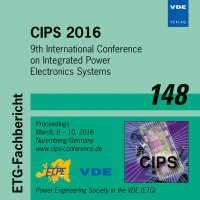Thermal Performance and Reliability of Copper Thick Film Substrates
Conference: CIPS 2016 - 9th International Conference on Integrated Power Electronics Systems
03/08/2016 - 03/10/2016 at Nürnberg, Deutschland
Proceedings: CIPS 2016
Pages: 6Language: englishTyp: PDF
Personal VDE Members are entitled to a 10% discount on this title
Authors:
Gundel, Paul; Bawohl, Melanie; Challingsworth, Mark; Czwickla, Christoph; Garcia, Virginia; Nikolaidis, Ilias; Modes, Christina; Persons, Ryan; Reitz, Jessica; Shahbazi, Caitlin (Heraeus Deutschland GmbH & Co. KG, Heraeusstr. 12-14, 63450 Hanau, Germany)
Nowak, Torsten (Fraunhofer-Institut für Zuverlässigkeit und Mikrointegration IZM, Gustav-Meyer-Allee 25, 13355 Berlin, Germany)
Abstract:
Direct Bonded Copper (DBC) is the standard substrate technology for power electronics and also used in many high brightness LED applications. This paper presents Thick Printed Copper (TPC) as mass production proven alternative technology for a broad spectrum of applications with an emphasis on the thermal performance and the reliability under thermal shock testing. The well-known drawbacks of DBC are the limited reliability under thermo-mechanical stress, the restrictions for thin copper layers and the limited spatial resolution of the copper structures. The outstanding high reliability of TPC for LEDs and power electronics is demonstrated in this paper by passive thermal shock tests from -40 °C to +150 °C in comparison to DBC. DBC (with and without dimples) and TPC made using various ceramic materials including alumina, Zirconia Toughened Alumina (ZTA) and aluminum nitride. The observed high reliability of TPC substrates is attributed to the low warpage variation of TPC and the wide bonding region, which extends up to 40 µm into the ceramic. At the same time, TPC cannot offer the same electrical and thermal conductivity as DBC. The 30 % lower conductivity of the copper layer is caused by residual pores in the TPC layer after sintering and the adhesion promoting additives in the layer. The effect of the reduced conductivity is simulated with finite element modelling using the example of a high brightness flip-chip LED module. The results show that the difference between DBC and TPC is negligible on aluminum nitride and that the difference can be easily compensated by using thinner copper layers for alumina substrates. This highlights the excellent applicability of TPC for LEDs as well as for power electronics.


